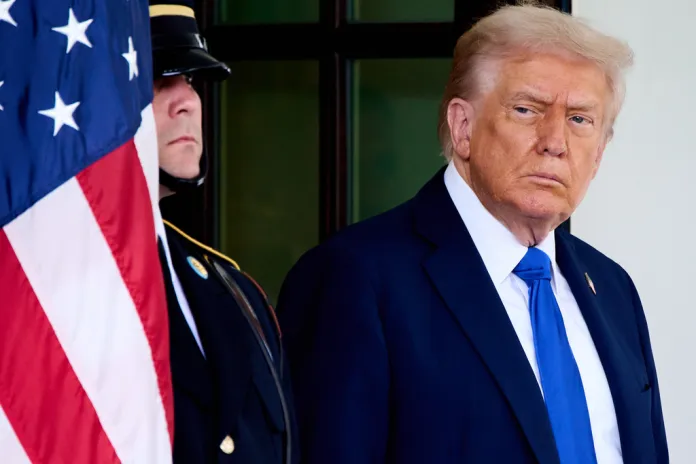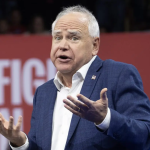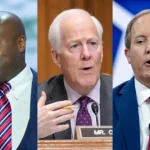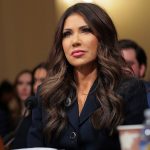President Donald Trump is rewriting the federal government’s shutdown playbook, keeping politically symbolic programs alive and pausing others he opposes.
While large swaths of the federal workforce remain furloughed, the administration has kept certain agencies and initiatives running by stretching legal definitions of what counts as “essential.”
Meanwhile, he’s announced he will inflict pain in a way that would hurt his opponents the most. Aside from cutting programs in blue states, Trump said Office of Management and Budget Director Russ Vought would implement permanent layoffs or program eliminations by first targeting “Democrat Agencies.”
The dynamic has resulted in a patchwork shutdown under Trump’s control that shields politically symbolic or ideologically aligned programs while freezing others that have historically been insulated from shutdowns. Trump picking the winners and losers also makes him a central power broker over the shutdown, and Republicans seek to put the blame squarely on congressional Democrats for the funding lapse.
Political strategists say the administration’s selective approach reflects sophistication and risks going too far.
“Like so much else, Trump 2.0 is different from Trump 1.0,” Republican strategist Dennis Lennox told the Washington Examiner. “Sure, he has a more docile Congress, particularly House Republicans, but we’re seeing an administration that on the whole is more politically adept. Their political calculus says many Americans won’t care as long as their vacation to the Grand Canyon isn’t ruined. The only question is what happens when they can’t get home because air traffic controllers have called in sick or airlines flying Essential Air Service routes cancel flights.”
One example of the uneven approach to the shutdown is at the National Park Service. Major destinations such as the Statue of Liberty and the Grand Canyon were left open, whereas they were deemed closed in Trump’s first shutdown, but states stepped in with non-federal funds to keep them afloat.
Meanwhile, dozens of smaller sites, including Muir Woods and Fort Point in California and visitor centers at Great Sand Dunes and the C&O Canal, have closed entirely or are operating without staff. The result is a two-tier system where the nation’s most iconic landmarks stay accessible while lesser-known parks go dark.
At the Interior Department, most employees have been furloughed, but the Bureau of Land Management continues to process drilling and mining permits funded through industry fees. That work is exempt from the shutdown because it draws on nonappropriated revenue sources rather than annual congressional funding. During previous shutdowns, including those in 2013 and 2018-19, such permitting largely halted as agencies suspended nonessential functions. The change highlights the administration’s willingness to keep energy projects moving while sidelining environmental enforcement.
Inside the White House, the selective exemptions are just as pronounced. About one-third of staff are slated for furlough, but key political and coordination units, including the Department of Government Efficiency and OMB, are fully or mostly exempt, according to Politico. All 45 DOGE employees remain on duty because annual appropriations do not fund their salaries. OMB is keeping 437 of its 530 employees working to direct budget operations and manage shutdown strategy.
The White House is keeping much of the General Services Administration running, working on real estate consolidation, contract streamlining, and digital modernization — all part of Trump’s plan to shrink the federal footprint.
Other internal directives point to a deeper structural ambition. For the first time, the administration’s guidance to agencies explicitly designates layoff planning and reductions in force as exempt activities, meaning agencies can continue preparing permanent workforce cuts during the shutdown. In previous shutdowns, these actions were typically paused.
Adding to that pressure, the administration has also threatened to deny back pay for furloughed employees, a sharp break from past practice under both parties. In a memo to Vought, OMB General Counsel Mark Paoletta concluded that the federal government is under no legal obligation to pay furloughed staff retroactively once the shutdown ends. The guidance would affect career civil servants and Trump-appointed officials, escalating anxiety across agencies already bracing for layoffs.
Outside Washington, the administration’s selective approach has shaped where federal money flows. The Department of Transportation has warned that subsidies under the Essential Air Service program could begin lapsing as early as Sunday due to the shutdown, possibly cutting off air access for rural communities. During the first Trump administration, the White House proposed killing the EAS program, but Congress opted to boost funding instead. The program subsidizes two round-trips a day using 30- to 50-seat aircraft or more frequent service with smaller planes, supporting service in roughly 65 communities in Alaska and 112 across the rest of the country and Puerto Rico.
At the same time, the White House has found ways to shield certain politically sensitive programs from the shutdown’s effects. On Tuesday, press secretary Karoline Leavitt announced that the administration would use tariff revenue to keep the Special Supplemental Nutrition Program for Women, Infants, and Children funded through the shutdown.
“Thankfully, President Trump and the White House have identified a creative solution to transfer resources from Section 232 tariff revenue to this critical program,” Leavitt said in a statement on X, blaming Democrats for the funding lapse.

Meanwhile, the White House has frozen $2.1 billion in Chicago infrastructure funding, including the Red Line Extension and other major transit upgrades, citing objections to race-based contracting rules. Administration officials describe the move as part of a broader review to ensure federal dollars are not being distributed through “discriminatory or unconstitutional” diversity and equity requirements, a process they say is permitted during the funding lapse.
Similar freezes have been imposed elsewhere as part of the administration’s shutdown management. In New York City, roughly $18 billion in federally backed projects, including the Hudson Tunnel Gateway Program and Second Avenue Subway, have been placed on hold as the White House examines whether local contracting standards violate its diversity, equity, and inclusion ban.
The administration has also halted or delayed nearly $8 billion in energy and infrastructure projects across 16 Democrat-led states, according to the Department of Energy. Officials describe the actions as fiscal oversight during the shutdown, but opponents call them politically motivated moves in the middle of a crisis.
Sen. Andy Kim (D-NJ) said the pattern reflects “mob boss tactics” designed to exert pressure through disruption. “It’s honestly something that really shows just how crass and just how far the Trump administration is going,” he said at a news conference Tuesday.
Sen. Mike Rounds (R-SD) defended the president’s discretion, saying the executive branch “has to make choices” when Congress fails to fund the government. “The Senate Democrats don’t feel that these jobs are important enough to pay for,” Rounds said. “If you’re not going to have the appropriations process move forward, then in the executive branch, he makes decisions about how to manage it.”
TRUMP’S SHUTDOWN WORKFORCE THREATS COULD BACKFIRE
Democratic strategist Jon Reinish countered that the administration’s hard-line tactics could eventually backfire. “There are smart people in that building who know this isn’t just about leverage,” he said. “They’re thinking about what this means for upcoming elections in places like Virginia and for federal workers in purple districts heading into a midterm year.”
Reinish said Democratic leaders are proceeding cautiously but believe the political blame still falls squarely on Republicans. “[Senate Minority Leader Chuck Schumer (D-NY)] and [House Minority Leader Hakeem Jeffries (D-NY)] have gotten the message that if they either do or are seen as bringing the typical Democrat butter knife to a howitzer fight, they will face an all-out rebellion, not just from the base but even a lot of their colleagues,” he said. “For now, Democrats think they’re doing this right, but that calculus could change if voters start feeling the pain.”























